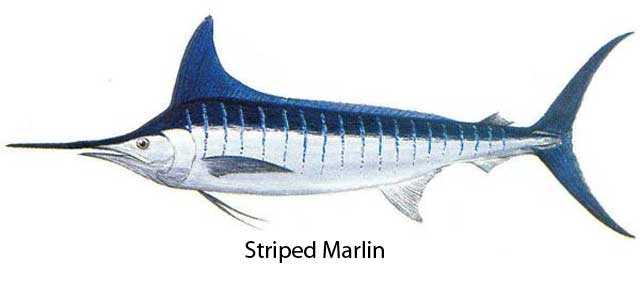
STRIPED MARLIN

Tetrapturus audax
Spanish: Marlin Rayado
The body of the striped marlin is elongate and compressed. The upper jaw is much extended, forming a rounded spear. Smaller than the blue marlin, the striped marlin has a dark steely blue back that is lined with dark cobalt blue or lavender stripes (coloration varies with location), fading to a silvery white underside.
The striped marlin normally develops conspicuous stripes along the sides of its body after death. This feature is unique to striped marlin.
The first dorsal fin at its highest point, is from 75% to a 100% of the body depth, measured at that point on the body, with the length going back to almost the second dorsal fin. The striped marlin's dorsal fin is generally higher in its total height than other marlin species. The dorsal fin has many dark black to purplish-black spots scattered throughout with a light purplish or violet blue background. The anterior part of the dorsal is pointed like the blue marlin. The second dorsal is slightly posterior to the second anal fin and is also pointed.
The pectoral fins of the striped are pointed, fold easily against the body and are slightly shorter than the longer pectoral fins of the sailfish. Striped marlin pectoral fins are generally straight, with a slight curve on the bottom. However, they are not as curved as the blue or black marlin, nor are they as wide as the blue or black marlins.
The striped marlin has the most pronounced vertical line markings, hence the name. Generally fourteen to twenty vertical stripes from the true gill plate to the caudal peduncle. The stripes are prominent lavender to blue in color.
The bill of the Striped Marlin can be used for defense and as an aid in capturing food. Wooden boats have been pierced by the Marlins bill. When the bill is being used for feeding it swims through schooling baitfish thrashing its bill from side to side stunning and injuring the bait fish. The Striped Marlin then easily captures and eats the fish. Fish that are included in the Striped Marlin's diet are anchovies, pilchardsflying fish, sauries, and mackerel. The stripers diet also includes squid.
World Record - 494 Lbs.Caught in Tutakaka, New Zealand on Jan. 16, 1986.